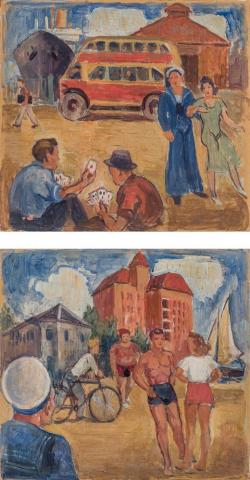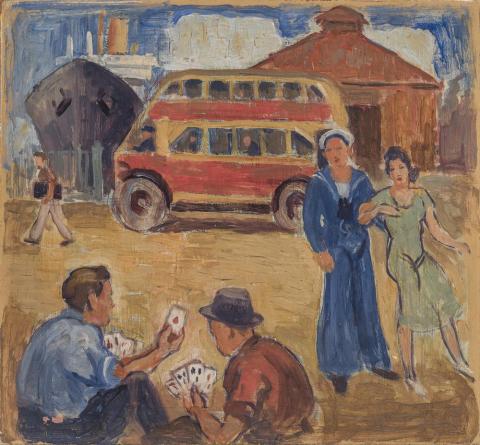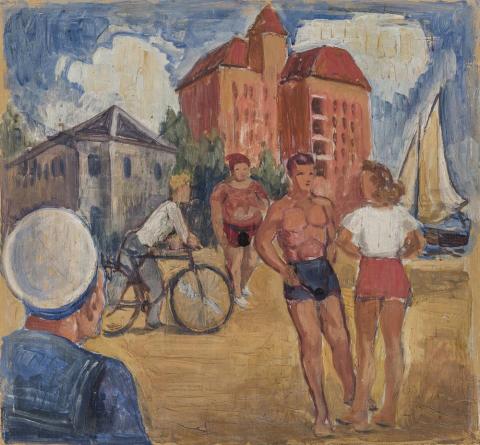WOOLLOOMOOLOO and POTTS POINT, 1940
ROLAND WAKELIN
oil on two wood panels
41.0 x 43.5 cm image, each
Collection of the artist, Sydney
Thence by descent
The Estate of Judith Murray, Sydney
This pair of wood panels featured on the doors of a lowboy cupboard owned by the Wakelin family from their time at Challis Avenue, Potts Point (1939 – 42). The lowboy stayed with the family through moves to Neutral Bay and Double Bay, and was dismantled by the artist’s son and grandson when the Wakelin family moved to Rose Bay in 1968.
Roland Wakelin is one of the key names in the history of Australian modernism. He studied alongside Grace Cossington-Smith, Roy De Maistre and Constance Tempe Manning, and in 1919, he and De Maistre held their ground breaking Colour in Art exhibition which contained the first abstract paintings ever created in Australia. Wakelin adhered to a love of colour for the rest of his days and in 1925, at his first solo show at the renowned Macquarie Galleries, fellow artist Margaret Preston wrote in the introduction that ‘the work of Roland Wakelin is personal and thoughtful, full of aesthetic qualities; above all introspective, and characterized by a fine colour sense.’1 This introspection also informed his private life as a devoted husband and father, with his wife Estelle and children Roland and Judith frequently appearing in his paintings.
For many years, the family moved through a succession of rental properties on the lower north shore of Sydney near the harbour at Waverton and North Sydney (by the time daughter Judith was 15 she had already lived in 12 different homes). In 1939, they moved to a unit in Challis Avenue, Potts Point. The block was just back from the corner from Victoria Street, a location famed for its profusion of artist and activist residents through much of the 20th century. Only metres from the corner are the McElhone Stairs which plunge from the heights of Victoria Street to the low lying Cowper Wharf Road which hugs the harbour’s shore. From this vantage point, the whole of the Woolloomooloo wharves are laid out for view, a bustling scenario full of fascination for an observant artist like Wakelin, and the direct inspiration for these panels. According to a family history compiled by Judith, ‘in my “room” [a partitioned section of the verandah] there was also a lowboy for my clothes, a shelf for my books and an old cane chair. How I loved this tiny space! At some time I went away for a weekend and when I returned, my father had painted all the furniture cream and had also painted on the lowboy panels two pictures depicting life in the two suburbs, Potts Point and Woolloomooloo.’2
In Woolloomooloo, 1940 the Finger Wharf is the location with a cruise ship tied up at the pylons whilst a recently commissioned double-decker bus passes by in its distinctive livery of red and yellow. Observing a card game between wharfies, a sailor from nearby the Garden Island naval base pauses with his latest ‘pick-up’ – a somewhat risqué subject for the bedroom of a thirteen year old girl.3 Potts Point, 1940 by comparison, is a composite image. On an imagined harbourside beach, a sailor is again included whilst in the background the stylised form of the newly built Macleay Regis building (as seen from the rear in Billyard Avenue)4 becomes the main feature, befitting its status as the tallest apartment building in Sydney at that time.
Long cherished by generations of the Wakelin family, these lively mementos of a distinct time and place are offered for sale for the first time since their creation some 75 years ago.
1. Preston, M., Roland Wakelin, catalogue introduction, Macquarie Galleries, Sydney, 15 – 25 April 1925
2. Murray, J., A Painter’s Life, unpublished manuscript, p. 198
3. Wakelin exhibited a painting (not located) titled Woolloomooloo at Macquarie Galleries in the ‘Annual Show of Fives’ exhibition in February 1940. It is possible this wardrobe panel is a related study.
4. The author thanks Judy Dinkidi and Pete Stocks from the ‘Lost Sydney’ Facebook page for assistance in identifying this building.
ANDREW GAYNOR


